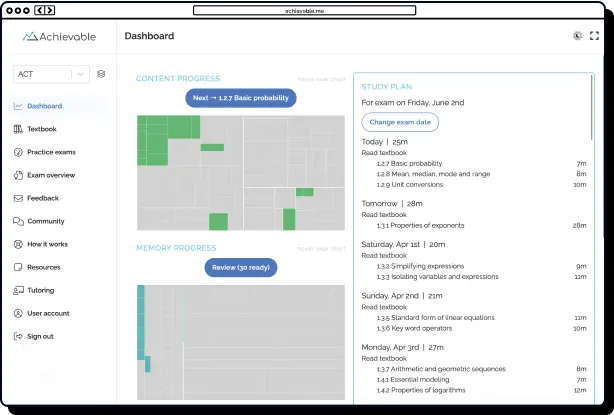
What’s new in the Enhanced ACT?




This year, the ACT announced significant updates to the popular college entrance exam in response to the evolving landscape of undergraduate admissions. The new “Enhanced ACT” is shorter, more tech-forward, and no longer requires the Science section. These ACT test changes began rolling out in April 2025 for the digital ACT and will impact students taking the ACT on paper or internationally in September.
Starting with the spring 2026 session, changes for mandatory state and district ACT testing will also take effect. This ensures consistent implementation of the enhanced ACT format and features across multiple testing platforms and regions.
What’s new with the ACT? In this guide, we’ll break down major updates, from scoring to category adjustments, so you can be prepared ahead of taking the exam.

What does this mean for ACT test-takers?
The latest enhancements to the ACT are designed to offer greater adaptability while also maintaining score validity and reliability. By narrowing the focus of the exam, administrators and universities can more accurately compare scores across differing student populations.
The updated ACT will feature a shorter test length and introduce new options such as the flexibility to include or exclude the Science section. The revised Composite score requirements will place increased emphasis on core sections (English, Math, and Reading), reflecting shifts in the subjects most valued by colleges. For students opting to complete the optional science section, those scores will be reported separately from their main ACT scores.
Why the change?
The recent ACT test changes are driven by valuable feedback from students and educators. They focus on greater flexibility and expanded options for today’s test-takers. These enhancements aim to modernize the exam, offering updated features and a more streamlined format. With the Enhanced ACT, students can enjoy a refreshed, relevant testing experience that aligns with current educational standards and expectations.
What are the changes?
- Test format: Students have a split preference between digital and paper testing. The original format was on paper with bubbles to fill in; now, students have the option to take the test on a computer in a proctored setting.
- Flexibility: Like the writing section, the Science section is now optional. Students will take the English, Math, and Reading sections to complete their Composite score.
- Online calculator: The online Desmos calculator will now be available for the weekend exams, as it was previously only available for the weekday exams. Students still have the option to bring their own approved calculators for the exam.
- Category adjustments: The reporting categories will be adjusted to achieve a more balanced overall representation. Additionally, questions in each subject will be reviewed and adjusted as needed.
- Accessibility: The online test option offers accessibility features, including page zooming, text-to-speech, and answer elimination.
- Content: The content in the exams will be predominantly the same as before. The only real content changes will be to the English and Reading sections: passages will be slightly shorter to accommodate students with varying reading speeds.

Question and time allotment changes
Below is a table outlining the updated number of questions and the amount of time (in minutes) now allotted to each section of the ACT. These adjustments affect the length of the ACT for test-takers, depending on the test version:
| Test | Category | English | Reading | Math | Total |
|---|---|---|---|---|---|
| Old ACT | Questions | 75 | 40 | 60 | 175 |
| Time | 45 | 35 | 60 | 140 | |
| New ACT | Questions | 50 | 36 | 45 | 131 |
| Time | 35 | 40 | 50 | 125 |
As detailed above, the latest version reduces both the total number of questions and overall testing time. However, the length of the ACT remains sufficient for students to approach each item thoughtfully; the allocation of minutes per question is carefully balanced to sustain a fair test-taking pace. These modifications help streamline the process without sacrificing the exam’s level of difficulty.
The table intentionally focuses only on the three major sections: English, Reading, and Math. This targeted comparison clarifies how the new time and question count structure impacts the primary portions of the exam.
For those wondering about changes to the optional Science section, the revised format now allocates 40 minutes to work through 40 questions, granting students one minute per question. The previous version provided only 35 minutes for the same number of questions. For all sections, experimental questions will now be subtly embedded within the test, rather than appearing after the core content.
The current ACT exam takes approximately 125 minutes to complete, excluding the Science section, compared to nearly three hours for the previous exam. With Science, the total test time extends to roughly 165 minutes. These carefully considered adjustments reduce the length of the ACT and ensure a consistent and fair testing experience for all students, while upholding rigor across every section.
Change in time per section
Below is a chart showing the average time students spend on each question, in seconds.
| Section | Before | After | Total change |
|---|---|---|---|
| English | 36 sec | 42 sec | 6 sec (17%) |
| Reading | 53 sec | 67 sec | 14 sec (27%) |
| Math | 60 sec | 67 sec | 7 sec (11%) |
| Science | 53 sec | 60 sec | 7.5 sec (15%) |
As you can see, the time allocated for each question has increased, ensuring that students have sufficient time to answer every item. This helps decrease the number of students who run out of time and fail to finish. Completing more questions on the exam improves their chances of getting a higher score.
Bring your own device
If you are wondering if you can bring your own computer to the digital exam, the answer is yes! However, only Windows and Chromebook computers will work. Most Apple devices are currently unsupported and will not work on the ACT.
Most testing facilities will have computers available for use during the exam, but it is preferred to bring your own device and use the school computers only if absolutely necessary. If you plan on bringing your own computer, make sure it is capable of running the ACT Gateway application.
Below is a table that lays out the dates of the upcoming 2025 exams and when your device needs to be ready by, according to the official ACT website:
| Test date | Registration deadline | Device prep deadline |
|---|---|---|
| February 8, 2025 | January 3, 2025 | January 30, 2025 |
| April 5, 2025 | February 28, 2025 | March 27, 2025 |
| June 14, 2025 | May 9, 2025 | June 5, 2025 |
| July 12, 2025 | June 6, 2025 | July 3, 2025 |
New ACT pricing
The ACT costs $68 for the core sections. As with the Writing section, students are now charged an additional fee to take the optional ACT Science section. The Science add-on fee is $4, which is significantly lower than the Writing fee of $25.

How will the scores change?
For the digital ACT exams administered from April through August, the ACT score range for the Composite score will be determined by averaging the Math, Reading, and English section scores. This adjusted Composite score will then be rounded to the nearest whole number, ensuring that the ACT scores range reflects only these three subjects.
The Science section will not contribute to your Composite score or influence your overall ACT score range on digital tests. However, if you opt for the paper-and-pencil version of the ACT within these same months, the Science section will continue to be included in the calculation of your overall Composite score. Starting with the September 2025 test, both digital and paper versions will calculate the Composite score based exclusively on the average of the English, Math, and Reading sections.
What’s next?
The official ACT prep guide is set to undergo major revisions in response to the recent ACT test changes. Due to these updates, the ACT may introduce new question formats and updated content accessible to parents, tutors, and students; however, the organization has not yet released detailed information or a timeline regarding these updates.
Given how new these enhancements are, it’s crucial to remain informed as the ACT announces further developments. The ACT is still working through many of the ancillary details surrounding these test changes, so staying updated will help you adapt to any modifications more effectively.
Helpful tips from previous testers
A major shift in testing format can alter how people take a test, so it’s important to become familiar with the changes before sitting for the actual exam. Some past test-takers noticed a slight difference in timing, but still found the overall exam to be long. Others appreciated that the exam is now more flexible and modular while still maintaining the feel and rigor of the previous test. The English section, in particular, has been reported to be very similar to the previous format and practice exams. Some test takers have pointed out that the scrolling function for reading passages on the digital ACT can be slightly inconvenient. The best way to avoid hiccups is to take a few practice exams with the new format and get comfortable with the updated tools; this will make test day easier for you.

Conclusion
Enhanced ACT test changes aim to improve content, processes, and the overall testing experience for students. The new digital format, along with innovative features and revised timing, was introduced to make the testing process smoother and more efficient. Students will benefit from greater flexibility and expanded choices, which will support their academic growth and increase their chances of achieving higher scores.
In the coming months, further details about the Enhanced ACT and other specific ACT test changes will be released to clarify what to expect and provide important updates. As a student, you can look forward to these new opportunities and enhancements as you prepare for the ACT.

